CONTENTS
Overrated Joe
Pitt Turns Down the Rose
Redskins Hall of Famers
Coca Cola Classic
Perrilloux Ripple Effect
Football:
Did You Know? I
Football: Did You
Know? II
Football: Did You
Know? III
Football: Did You
Know? IV
Football: Did You
Know? VI
Football: Did You
Know? VII
Football Magazine
Golden Rankings Home
Top of Page |
Football:
Did You Know? –V
|
Overrated Joe

Joe Namath in Super Bowl III |
Joe Namath made an enormous impact on the NFL when he led the New York Jets to their upset win over the heavily-favored Baltimore Colts in Super Bowl III after the 1968 season. The victory established the American Football Conference, composed of teams merging from the American Football League, as the equal of the older National Football Conference.
Primarily as a result of that one game, Joe was elected to the Pro Football Hall of Fame in 1985. However, when you look at his statistics, you can legitimately ask whether he deserved the honor.
- In his 13-year career, he threw 220 INTs but only 173 TDs.
- His career QB rating (a stat not developed until after he retired) was only 65.5. By comparison, Joe Montana's career rating was 92.2, and John Elway was 79.9.
- The most telling stat is this: after the 1968 championship season, he won only two games against winning teams for the remaining eight years of his career.
- The Jets made the playoffs after the 1969 season but lost to Kansas City 13-6. Joe never appeared in another playoff game the rest of his career.
|
|
|
Pitt Turns Down the Rose
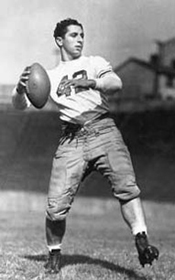 Marshall Goldberg
Marshall Goldberg
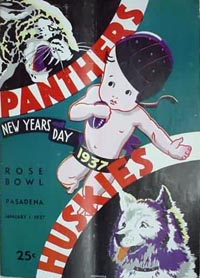 |
The 1937 Pittsburgh Panthers finished 8-0-1. The blemish was a scoreless tie against Fordham and the "Seven Blocks of Granite," which included future coaching great Vince Lombardi. Generally considered "Doc" Sutherland's greatest team, Pitt boasted the "Dream Backfield" of Marshall Goldberg, Dick Cassiano, John Chickerneo, and Harry "Curly" Stubbins. The squad was #1 in the final AP poll. As a result, they were invited to play in the Rose Bowl for the second straight year.
Shockingly, at least to the outside world, the team voted 17-16 against the trip to Pasadena. Goldberg later said there were several reasons for the negative vote, but a telling one was "what happened to us the year before."
The 1936 Panthers had compiled an 8-1 regular season record and trounced Washington 21-0 in the Rose Bowl. The players had been led to believe that each would be paid $100 for expenses and given a new suit. "We got nothing except a sweater and a pair of pants," Goldberg recalled. The coaches chipped in what they could, but all that amounted to was $2 per player.
As background to the players' decision, Pitt had paid its football players since the mid-20s. In 1933, the salaries, which appeared high by Depression standards, were cut to $40/month, and the players were expected to pay their own room, board, and tuition. In 1934-6, players got $48/month for ten months. The school also prohibited married football players and required players to hold down jobs in exchange for tuition and board. Chancellor John Bowman wanted to bring his football program in line with those of other prominent schools. He hoped to take Chicago's place when that school left the Big Ten. (That happened in 1939 for football, but the Big Ten did not accept a replacement until Michigan State in 1953.)
The deemphasis of football soon took its toll. Sutherland retired after the 1938 season. Before the next season, the freshmen players went on strike, protesting the reductions that gave them a lower salary than previous players. They succeeded in getting the administration to cancel the reductions. Then in 1940, the Panthers suffered their first losing season since 1912. |
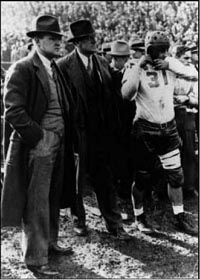 Jock Sutherland (center)
Jock Sutherland (center) |
References: Football Feuds: The Greatest College Football Rivalries, Ken Rappoport & Barry Wilner
College Football: History, Spectacle, Controversy: John Sayle Watterson
|
|
The NFL Hall of Fame class of 2008 included two former Washington Redskins, Art Monk and Darrell Green. In conjunction with their induction, The Washington Post included tidbits about the other Redskins in the Hall.
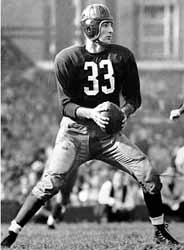 Sammy Baugh
Sammy Baugh
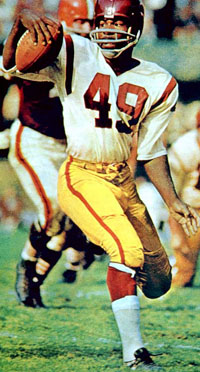
Bobby Mitchell
|
- "Slingin' Sammy" Baugh revolutionized football by popularizing the forward pass. He was all-NFL seven times while winning six passing titles. In 1943, he led the league in passing, punting, and interceptions. Because of this versatility, he is arguably the greatest football player ever. When Monk and Green were inducted, Sammy was 94, the last living member of the Hall's inaugural class of 1963.
- Lineman "Turk" Edwards moved with the franchise when it transferred from Boston to Washington in 1937. At 6'2" 255 lb, he was a giant on both sides of the ball. His career ended abruptly in 1940 in a unique manner. After participating in the coin toss before a game, he turned to return to the bench. His cleat caught in the ground, and his knee gave way.
- The owner who transferred the franchise to Washington was George Preston Marshall. Longtime Washington columnist Shirley Povich wrote that Marshall "was widely considered (1) one of pro football's greatest innovators and (2) its leading bigot." He started the Redskins marching band, which still exists. His team, however, was the last to integrate, doing so only when the federal government threatened to take legal action in 1962.
- Marshall's first African-American player was Bobby Mitchell, a WR/HB who started his pro career with the Cleveland Browns (1958-61) before finishing with Washington (1962-68). Mitchell caught at least 50 passes six times, finishing with 521 career receptions and 14,078 net yards.
- RB John Riggins was MVP of the Redskins' first Super Bowl victory after the 1982 season. He had sat out the 1980 season but returned for 1981. "I'm bored, I'm broke, and I'm back."
|
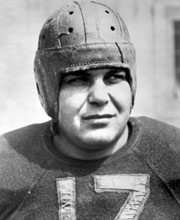 Turk Edwards
Turk Edwards
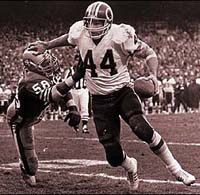
John Riggins
|
Reference: "Washington Monuments," The Washington Post, July 31, 2008 |
|
Coca Cola Classic
The Coca Cola Classic was held every year from 1986-1993. Two schools agreed to move their regular season game to Tokyo.
1986 |
Stanford 29 Arizona 24 |
1987 |
California 17 Washington State 17 |
1988 |
Oklahoma State 45 Texas Tech 42 |
1989 |
Syracuse 24 Louisville 13 |
1990 |
Houston 62 Arizona State 45 |
1991 |
Clemson 33 Duke 21 |
1992 |
Nebraska 38 Kansas State 24 |
1993 |
Wisconsin 41 Michigan State 20 |
From 1977-1985, the game was called the Mirage Bowl. Since it involved a regular season contest moved to Tokyo, it was not actually a bowl game.
1977 |
Grambling 35 Temple 32 |
1978 |
Temple 28 Boston College 24 |
1979 |
Notre Dame 40 Miami (FL) 15 |
1980 |
UCLA 34 Oregon State 3 |
1981 |
Air Force 21 San Diego State 16 |
1982 |
Clemson 21 Wake Forest 17 |
1983 |
SMU 34 Houston 12 |
1984 |
Army 45 Montana 31 |
| 1985 |
USC 20 Oregon 6 |
From 1977-1987, the games were played at Korakuen Stadium, a 50,000-seat baseball stadium that was home of the Yomiuri Giants. Starting in 1988, they were played in the 42,000 capacity Tokyo Dome, which was built on the site of the previous stadium.
|
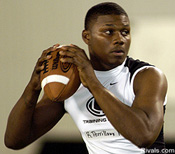
Ryan Perrilloux
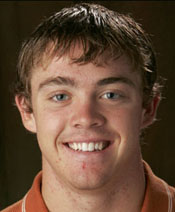
Colt McCoy
|
The recruitment of Louisianian Ryan Perrilloux affected the fortunes of four schools and four Texas high school QBs.
- Originally (2005), Perrilloux, the 5-star QB who was #1 on every ranking of prospects, committed to Texas, which had already gotten a commitment from 3-star Colt McCoy from Jim Ned High School (isn't that a quintessential name for a Texas school?) in Tuscola, population 714.
- Because Mack Brown now had two blue-chip QB commitments, he showed no interest in the 3-star QB of Carroll High School near Dallas. So Chase Daniel committed to Missouri.
- Meanwhile, McCoy kept his options open as signing day 2006 approached.
- Early in 2006, Perrilloux switched to LSU. That caused McCoy to stay with Texas, where he had a great career, leading the Longhorns to the 2009 BCS Championship Game.
- Texas made an eleventh-hour bid for Daniel, who admits that he wanted to go to UT originally. However, Chase remained loyal to Mizzou. As a junior, he led the Tigers to their best season in decades and was also a Heisman contender.
- Perrilloux led the Tigers to victory in the 2007 SEC Championship Game against Tennessee to vault them into the BCS Championship Game when starter Matt Flynn was injured. But he was dismissed from the team by Coach Les Miles before the 2008 season. Perrilloux toiled two years for Jacksonville State in the obscurity of the Ohio Valley Conference.
- Meanwhile, LSU's 2008 starter was 4-star Jarrett Lee of Brenham TX, a redshirt freshman whose INTs were the difference in the Tigers' loss to, among other teams, Georgia and its 5-star QB Matthew Stafford from Dallas.
|
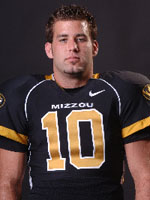
Chase Daniel
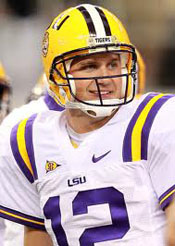
Jarrett Lee
|
|
|











